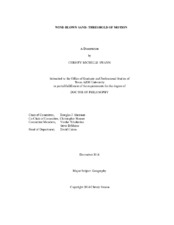| dc.description.abstract | The fluid threshold for wind-blown sand is the minimum shear velocity required to initiate grain movement by the force of the wind alone, and is used to predict dust emission and landform change in sandy environments. R.A. Bagnold derived the most commonly cited model of the threshold from a set of wind tunnel experiments. He visually observed the fluid threshold by measuring flow conditions corresponding to the initiation of bedload movement, a mode of transport that occurs prior to saltation. His model was developed using unimodal grain size populations and requires only the average size to predict the threshold. However, field environments often exhibit non-unimodal surface populations. The fluid threshold for mixed size surfaces in fluvial environments corresponds to the coarsest grain size, not the average, resulting in a larger threshold shear velocity to initiate movement. Larger thresholds yield smaller transport rates and could explain the consistent over-prediction of aeolian transport models. Yet, the fluid threshold of mixed size sands has not been tested in an aeolian field environment. This is due to the previous inability to separate the bedload from saltation.
The purpose of this research is to test Bagnold’s model of the fluid threshold in a field environment composed of dry, naturally mixed grain sizes in Jericoacoara, Brazil. A bedload trap was designed to separate bedload from saltation, and the initiation of bedload and near surface flow conditions were measured simultaneously. Field observations were compared to Bagnold’s model as well as other models of the fluid threshold.
Observed fluid thresholds did not vary with average grain size for the mixed size population. The thresholds for finer and coarser bedload samples were approximately equal to the Bagnold-predicted threshold for coarser grains. All models tested under predicted the threshold for finer grains. These results suggest the fluid threshold for mixed size sands corresponds to the coarsest grain size fraction, similar to the results found in fluvial | en |


